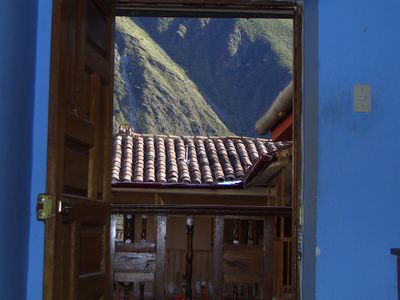Diane: We arrived in Ollantaytambo last night in the dark. After passing the central plaza, the bus let us off at the train station (go figure). There was no public bathroom in the vicinity, so I walked into a crowded restaurant to use their bathroom, which required that I go out a back door, through the mud, and by some people's bedrooms in the dark. Once back on the street, I was ready to find one of the hostals recommended in our guide. I asked one of the street vendors where the hostal was. Neither she nor anyone around her had heard of it. We decided to find a taxi and let them help us figure out where the hostal was. The cab driver had not heard of the hostal, or the street where it was located, Atoq K'ikllu. I could tell we were in the Ketchua heartland just by that street name. Ketchua or Quechua or any variant therein was the language of the Incas and is still the primary language spoken by many in the Andes of Ecuador and Peru. The taxi driver did drive us around the 3 or 4 streets that made up the town, but was unable to locate the street or hotel we were looking for. He dropped us in the central plaza, overcharged us, and went on his way. A woman approached us, who evidently worked at the hostal we were seeking, the Hostal Chaskawasa (more Ketchua). Well, someone was looking out for us. We walked up a narrow cobblestone street, so narrow that no cars would fit there.
We woke up in the morning to a spectacular view of straight-up mountains seemingly just outside our room.
The view looking out the hostal's front door was equally amazing, but for different reasons. You could still see the fine original Incan stonework at the foundation of the building across the way. The wall above was newer, used smaller stones, and filler between the stones, but the lower stones bore the unmistakable markings of Incan stonework. These buildings have been inhabited continuously since Inca times (the 1400's). Way cool!
Everybody else slept in, so I went for a walk around town, checking out the construction techniques. Two streets over is an irrigation canal that flows right through the center of the town. The flow is so strong, there are patches of white water. One street over, in the other direction, there is another one. More evidence that the Incas were experts at manipulating water flow. Unbelievable that it is also still fully functional. Large flat stones provide small bridges over these canals to each of the homes lining the street.
The cross streets provided wonderful views up into the mountains. Right next to me a rock wall leads up to some homes with red tile roofs. Following the line of the wall, my eye comes to Incan stone terraces running up the hillside. Above the terraces, a large mountain of rock looms. Each construction is magnificent in its own way.
Each street I walk down, each direction I turn, provides another majestic view from human construction to the mountains on all sides.
They have kept the tradition of rooftop sculptures here. They call them, torritos, "small bulls".
Each of these streets is too narrow for cars. I see only pedestrian and wheelbarrow traffic. Now I understand, why the taxi driver didn't know where to go last night. He never drives these streets, because cars don't fit here. A taxi driver does not know the street names in his own town. I got a map of Ollantaytambo from the "tourist office" in the local museum. Although it does show the town's soccer field (cancha), it lacks any street names.
As it turns out, this map was neither very useful, nor very necessary.
Everybody I came across, seemed friendly. They spoke to me, but in their native Ketchua. Only after I spoke Spanish did they respond in Spanish. And once they said, "Good morning", they'd exhausted their knowledge of Spanish and, smiling, we went our separate ways.
I love this place. It seems a bit of magic, a place out of time. The trains and buses full of tourists arriving from Cusco and Machu Picchu are, unfortunately, a strong force for change. Already, it's hard to find a non-tourist-oriented restaurant. I'm rooting for Ollantaytambo to preserve its way of life, its identity, its bit of magic.

No comments:
Post a Comment